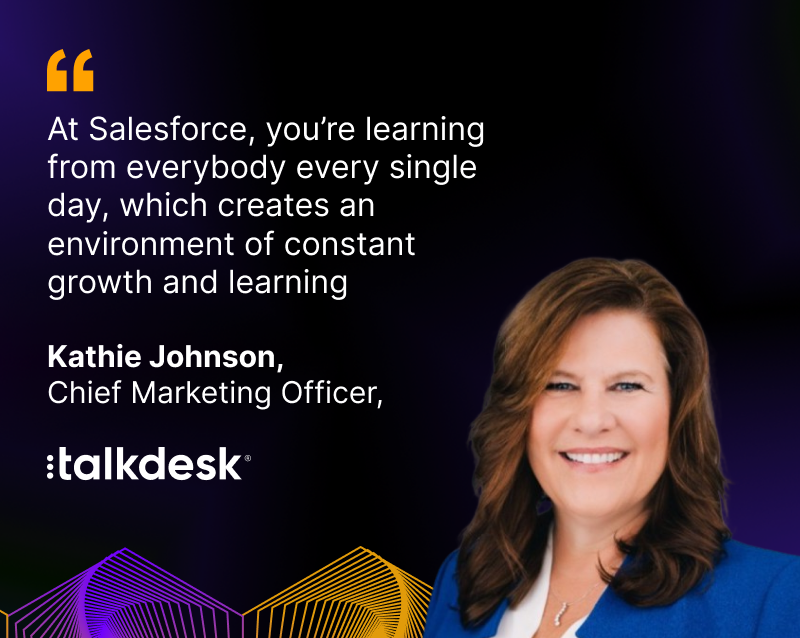Marketing Lessons From Salesforce to Startups: Meet Kathie Johnson from Talkdesk

Maximize Your Marketing ROI
Join 10,000 other marketers already getting the best tips on running engaging events that boost pipeline and create raving fans.
In this episode of CMO Diaries, Kishore met with Kathie Johnson, Chief Marketing Officer at TalkDesk.
Talkdesk provides a better way for organizations to intelligently unlock the promise and potential of great customer experience. Their speed of innovation and global footprint reflect their commitment to ensuring businesses everywhere can deliver better customer experiences through any channel, resulting in higher customer satisfaction, cost savings, and profitability.
Kathie has an impressive background in tech with leadership roles at companies including Dassault Systèmes and Salesforce. She’s also very active in the business community as a founding member of CMO Huddles and a member of The CMO Club.
She joined us to talk about her most successful (and fun!) marketing campaigns, lessons she learned moving from a very large company (Salesforce) to a small startup (Talkdesk), and what channels drive Talkdesk’s Go-To-Market strategy.

Tell us about a really successful marketing campaign that you managed end-to-end.
A few years ago, I was at Dassault Systèmes. They are a software company located outside of Paris. And in one of the roles I had there, I was asked to take on brand.
When I joined, they were a company that had grown through over 45 acquisitions. Every individual company had their own branding and positioning. It wasn’t a cohesive company or a truly global brand.
I was tasked with figuring out things like how do we create one positioning for the company? How do we take that positioning and build the brand and awareness globally? As a French company, awareness in France was very high, around 72%. So how do we create one positioning for the entire company and increase our awareness globally?
If you’re not familiar with Dassault Systèmes, it’s a 3D experience company that leans heavily into product lifecycle management. You can design, test, and build products virtually. It’s essentially like building a virtual twin before you go build a real product. And when you think about it, it allows you to dream. It allows you to be inspired by what’s possible.
We ended up landing on positioning around “if we”. If we ask the right questions, we can change the world. Because when you ask the right questions, you can then test it, build it, simulate it, and manufacture it virtually to see if it will answer the question. That became the overall positioning.
👋 Psst! You can check out one of the “If we” campaign commercials here:
Our next challenge was, how do we bring all of these brands together beyond just branding them? We came up with an icon called The Compass, which allowed us to show all of the different brands and capabilities around a central visual.
We took this new message and created an integrated global campaign across television, radio, print, and digital. We built ads for every single one of our industries. We also made the decision, which wasn’t very mainstream at the time, to have a B2C feel and not come across as a typical B2B ad. The campaign was very aspirational and visionary. We asked, “How could you, if you ask the right questions, change the world?”
The campaign ended up winning over 12 awards, and we raised awareness in all 13 markets around the world.
One thing that’s really important to build this momentum is to build that passion internally. We took the “if we” campaign and re-wrote company values. We branded offices with the new messaging. It became part of the culture at Dassault Systèmes.
That’s one piece that folks sometimes forget to think through—How do you create that energy internally when you rebrand, reposition, and create a global campaign?
Is there something special about Salesforce in how they mentor marketing leaders?
There wasn’t a formal mentorship program, per se, but there were some secret sauces that Salesforce has brought along to help people come through the ranks and become a CMO.
One thing to think about—Mark Benioff started the “no software” campaign, which was brilliant. So, Salesforce already has a leader that’s gifted at marketing strategy and direction.
At Salesforce, there’s really a focus on excellence and training. Every marketer has the opportunity to do their best work there and to learn.
One of the things that Salesforce does that I haven’t seen elsewhere is that many people contribute to something, whether it’s writing a press release or building a campaign. You don’t just do a review with one person; there could be 20, 50, even 100 people that are adding intelligence, thoughts, and comments. You’re learning from everybody every single day, which creates an environment of constant growth and learning.

The second piece is Salesforce really invests in leadership training. When I was there, I participated in Leading for Growth, which is a leadership program for VPs and SVPs. I also got to participate in Leading Ohana, which is a leadership program for Senior Executive Leadership folks. In those programs, you learn about all of the skills of leadership. You learn how to test and run a business. There’s so much growth there. In addition, I was very fortunate to be invited to be faculty for those programs, which was another great way to learn.
The company invests in marketing training and leadership training, which even includes things like empathy, being a good leader, and being a good human. Any marketer that has a Salesforce journey comes out of that with a very well rounded background. They’re ready to take on the world and any leadership position like a CMO.
You went from Salesforce, a very large organization, to Talkdesk, a much smaller organization. Can you tell us what you learned making this transition?
If you’re going from a big company to a small company, figure out how you bring the sugar without the silver spoon. What do I mean by that? Well, how do you take all of the good elements that make sense in this new environment where you have fewer resources and a smaller budget and weed out the things you shouldn’t be doing because you’re at a much different stage as a company.
I like to think about this in three stages: Feed the business, build the business, create the future.
To “feed” the business, I thought about running the business today. At a small company that’s in hyper-growth mode, you also have to think about how you are building the business and creating the future.
To build the business and create the future, I spent time looking into what other companies in our space were doing and not doing. What was our core differentiation? How could I cut above the noise in a way that no one else in the space was doing? There are certain best practices that I borrowed from other companies and implemented those as well to help build the business and create the future.

Above and beyond that, one of the secret sauces at Salesforce was around the planning and culture piece. I also look beyond marketing. If you’re in a leadership position, how else can you influence the business overall to fuel growth.
For example, I brought over the V2M2, which is borrowed from Salesforce’s V2MOM. It stands for “Vision, Values, Methods, Metrics.” This created one planning methodology for the company and created alignment, prioritization, and transparency. We rolled it out company-wide, so we do it for the company, for each department, and then for each individual. Then, you report out against these aligned metrics.
Finally, I looked at the cultural elements. There were a few things I could bring without a heavy investment. I met with the CEO and got him on board to launch three employee resource groups: TalkDesk gives back, a group for Diversity, Equity, and Inclusion, and a group for Women in Tech. I also got buy-in for paid volunteer time off. That was a big piece of the culture at Salesforce. Now, every employee at Talkdesk gets one day off per quarter to give back.
As a leader, I looked at it from a marketing perspective but also transcended and looked at the company at large, which is part of our role as well.
What marketing channels drive Talkdesk’s Go-To-Market strategy?
First things first, segmentation is really important. Talkdesk touches everything from large enterprises all the way down to mid-market and SMB. What’s important is the motions are different across these segments.
The motions across the SMB segment are digitally-led. On the other end of the spectrum, enterprise is AMB-led. The middle of the funnel is very industry focused, and we have to be sure that we have the right content going out across the right channels to the right people. So, it’s a combination of channels for us.
“That’s one of the beauties of marketing. We have so many channels! The key is to pick the right channel for the right audience. Then, test, learn, and adapt.”
Do you have any book recommendations?
Yes! The first is The Five Dysfunctions of a Team: A Leadership Fable. If you have not read that book with your own leadership team, please read it! Work with the leadership team to talk through it. It’s one of my go-tos.
The other is Nine Minutes on Monday. This is such a practical book on tips for employee engagement. It’s very practical, hands-on, and gives you checklists of things to think about on Mondays. Our teams and employee engagement is so important.
—
Thanks so much for joining us Kathie! That’s all for this week, we’ll be back soon for another episode of CMO Diaries!

Transform Your Video Marketing with AI
Stay In Touch
Platform
Resources
© 2025 Copyright Goldcast, Inc. All rights reserved.





 Upcoming Events
Upcoming Events Event Series
Event Series On-Demand Events
On-Demand Events

